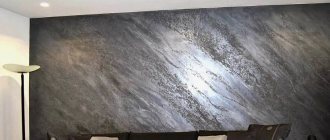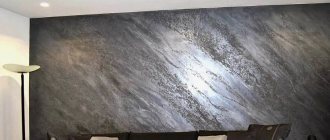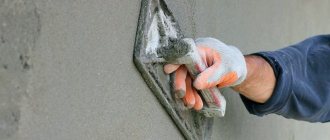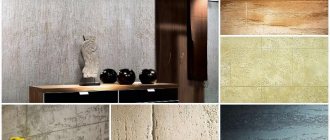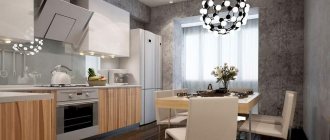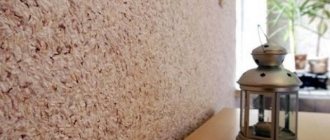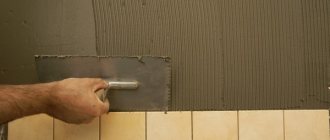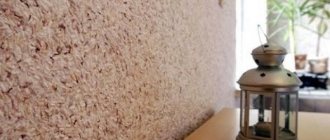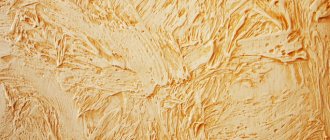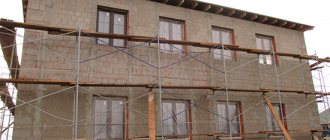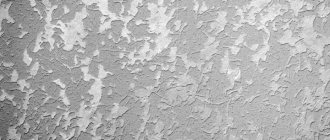No time to read? Watch the video!
Stores sell different types of decorative plaster for interior wall decoration. They differ in composition, namely the connecting element. Based on consistency, the products are divided into dry powder, which must first be diluted with water, and a ready-made paste mixture. It can be immediately applied to the surface. Regardless of the type of product, it has several advantages over other finishing coatings.
Types of decorative plaster
In total, the finishing materials market includes over a dozen types of decorative plaster. Each option differs in composition, color content, viscosity, ductility, elasticity during application, texture, processing time, and storage. Some mixtures are perfect for finishing the facades of houses, others - for finishing interior spaces.
Marble plaster with silver plating Source ural-resurs.su
Decorative plaster with mother of pearl Source decorstudia.com.ua
Silk
Plaster to which mother-of-pearl is added looks like silk-screen printing on the wall. Texture here is achieved by adding small grains of stone chips or cellulose fibers. Silk plaster has earned high marks for decorativeness due to the delicate tints of the finished coating. Glare appears depending on the viewing angle where natural or artificial light falls. Silk plaster is ideal for the living room, bedroom, library, study, any room where there is a lot of upholstered furniture.
Decorative silk plaster in the living room Source zen.yandex.ru
Bark beetle
Some interior styles harmoniously accept surfaces with an imitation of artificial aging or a protective layer spoiled by a bark beetle. For these purposes, it is appropriate to use decorative plaster in the interior with its interesting name - bark beetle. Such finishes give the style concept greater authenticity, originality and antiquity. The basic basis of this technology is a granular mixture.
Decorative plaster - chaotic bark beetle Source drive2.ru
Mosaic
The appearance of single-color walls with small specks is mosaic decorative plaster. There are mixtures with different particle sizes and different colors. It is used to decorate walls both outside buildings, houses, and indoors. The surfaces are smooth and easy to clean. They are resistant to chips, scratches, and impacts from heavy objects. This plaster fits perfectly on almost any surface - concrete, brick, standard plaster, plasterboard panel material. Another plus is good ventilation.
Decorative mosaic plaster in a children's room Source mirplaster.by
Art concrete
Art concrete is a modern finishing material for walls, ceilings and floors. The mixture contains dry cement and gypsum powder. Various additives, fillers, dyes, and varnishes are also added to them. Soft plasters allow you to create original imitations of a concrete surface. They are decorated with rivets, pipes (especially in the loft style), images of slabs, stacked blocks (ideal for high-tech or minimalism styles).
Decorative plaster coating art-concrete in the interior of a bedroom in a minimalist style Source design-homes.ru
Options
There are 2 options for such plaster - textured and Venetian:
- in the first case, the surface acquires a characteristic graininess;
- in the second it becomes almost smooth.
Textured
It is distinguished by mineral and synthetic fillers of small, medium and large fractions. Thanks to them, the surface is rough and grainy. Coarse-grained compositions create matte “bark beetle” and “mosaic” coatings . It is also used in techniques:
- "Antiko";
- "Travertine";
- "Marmorino";
- "Silk";
- "Sea breeze";
- "Concrete" and others.
There are 4 types:
- acrylic;
- silicone;
- silicate;
- mineral.
Advantages:
- a wide range of design ideas and styles;
- sold in finished form, with the exception of mineral;
- service life ranges from 10 to 50 years;
- texture is added with various tools - trowels, brushes, brooms, sponges;
- sets quickly, which saves time on work;
- easy to apply, does not require mixing;
- resistant to mechanical, thermal and ultraviolet influences;
- environmentally friendly, fireproof, does not emit toxic substances;
- easy to paint, restore (with the exception of silicone);
- increases the heat and sound insulation properties of coatings.
Flaws:
- formulations with improved performance characteristics are expensive;
- under shock loads they crack and chip;
- most mixtures are difficult to care for and difficult to clean;
- they set quickly, so they require prompt work;
- coarse fillers increase material consumption.
Can be used for both interior and exterior work. For facade finishing, silicone plaster is used. Acrylic is optimal in terms of price-quality ratio. It accumulates static electricity and dust, but is easy to clean unlike other materials. Mineral and silicate compositions are inexpensive, but their service life is significantly shorter (up to 15 years).
Venetian
Suitable for creating matte finishes. It is made on the basis of slaked lime, synthetic, polymer and acrylic binders , and also contains fine marble, granite or quartz dust and wax. Used in interior work using the following techniques:
- "Velvet";
- "Marble";
- "Veneto";
- "Marseille wax";
- "Trevignano";
- "Marbello";
- "Encausto."
Advantages:
- moisture resistance;
- vapor permeability;
- resistance to mechanical damage;
- high aesthetics;
- service life - from 20 years;
- possibility of tinting;
- rich range of colors;
- environmental friendliness;
- UV resistance.
Flaws:
- high price;
- increased consumption;
- applied in at least 3 layers;
- requires qualification when applying;
- careful surface preparation is required.
Venetian plaster can be imitated:
- natural stone;
- concrete;
- velvet;
- silks;
- marble.
These techniques require skill and teamwork . The required effect is achieved by applying several layers, which can be up to 10. It is released ready-made and dries completely after 24 hours.
Varieties by composition
Wall finishing material fillers have different features, functional and technical properties. If this is an option for decorating surfaces with gypsum or lime, then you can safely count on their strength. Such mixtures are usually used to finish the ceiling between beams in interior styles: Provence, country, chalet, vintage, retro, loft. Or when plastering sections of walls to look antique.
Decorative plaster in eco-style living room interior Source behance.net
Additional additives for decoration, creating an unusual coating:
- metallized threads;
- crushed shells;
- large cellulose fibers;
- pigments and colors.
Any decorative marble plaster in the living room, dining room, or hallway will not only beautifully recreate a beautiful pearlescent-shiny surface, but will also reliably protect the walls from various aggressive external factors. Neither mechanical damage, nor chemicals or detergents will damage the integrity of the coating. A number of other types of additives to plaster have the same or different properties.
Glossy marble plaster on the walls of the living room Source odnastroyka.ru
Features of choice for different interiors
The abundance of varieties of decorative plaster for interior and exterior finishing work allows you to create interesting coatings with high performance characteristics. A large selection of textures, colors, and components allows you not only to show your design imagination, but also to choose the best solutions for specific rooms. Each room requires individual selection of materials due to different locations and characteristics.
If everything is clear with the living room, corridor or bedroom, in living rooms it is already difficult to surprise with decorative plaster instead of traditional wallpaper. But increasingly, this type of finishing material is also preferred in less familiar places - in the bathroom, kitchen, dining room and even on the balcony. The main thing is to choose the right type of material in accordance with the operational features.
Plastering in the kitchen
The choice in favor of decorative plaster when finishing kitchen counters can be explained by ease of maintenance. This coating is easy to clean and allows the use of various detergents.
Finishing one wall in the kitchen Source pinterest.es
Combination of decorative plaster with finishing
If you need to determine what types of finishes decorative plaster can be combined with in the bedroom, then you need to pay attention to the texture, color and pattern of the surface. Finishing refers to different coverings of walls, their projections, columns, niches, as well as details of the decoration of the ceiling, window or interior arched openings.
Textured decorative wall decoration harmoniously combines with smooth wallpaper Source kordecor.ru
If the room is being furnished in a loft style, then a structural mixture or art-concrete plaster will work well with brick or stone masonry. For living rooms in a classic, English or Italian style, a combination of smooth surfaces of ordinary plaster, painted in the same tone, with marble decorative plaster would be ideal.
Marble decorative plaster serves as an ideal background for artistic decoration in the form of fish Source delaisteny.ru
Any authentic or ethnic style will look harmonious if you combine decorative bark beetle plaster with wooden surfaces - ceiling beams, curtain rods, shelves, furniture.
Decorative bark beetle plaster fits perfectly into the interior with wooden doors, panels, ceilings and furniture Source homedezen.com
Venetian plaster looks accentuated with a plain ceiling (painted or stretched). Artistic parquet or beautiful tiles are ideal for this exquisite wall covering.
Light Venetian plaster on the walls harmonizes well with the parquet floor and white ceiling Source parketluxe.ru
Marseille wax is most suitable for interiors in Provence, Baroque, and Country styles. It completely replaces the wallpaper functions. This type of wall decoration will harmonize wonderfully with gypsum stucco molding and elegant forging elements.
Artistic stucco on Marseilles wax plaster Source vatikam.com
Mosaic plaster, granite (or any composite finishing material), stone, brickwork is an ideal solution for combining two different finishing methods. The granite slab also has inclusions in the mosaic, so they go well together.
Mosaic plaster in combination with white painted wooden panels Source vplate.ru
Sea Breeze plaster has a palette of over 45 color options. Among them, the most popular ones are sandy, golden, sea green, pearl, light and dark mother-of-pearl, white gold, silver, chameleon. This allows the material to be used in tandem with decorative wallpaper, photo wallpaper, airbrushing and other types of plasters.
Decorating the wall with sea breeze decorative plaster combines harmoniously with parquet. Source oboitop.com.ua
Advantages and disadvantages
The most important advantage of the coating, which distinguishes it from others, is uniqueness. Even if the same master applies plaster in two adjacent rooms, he will not be able to repeat the final drawing.
Other advantages of the material:
- It can be combined with any interior styles and allows you to create a variety of effects.
- Additional soundproofing in the room.
- Resistance to moisture, temperature changes, and mechanical stress, which allows the material to be used even in the bathroom or on the balcony.
- Long service life.
- Resistant to mold and mildew.
- The ability to hide unevenness and other wall defects.
- Hypoallergenic, environmentally friendly, non-toxic, natural breathable structure.
- Versatility - can be applied to any type of surface (plasterboard, concrete, brick, wood and others).
- Easy to care for - can be washed, use any detergent.
A variety of textures and shades of finishing materials Source mirhat.ru
If the plaster is applied correctly, you can get an original, durable, practical and durable coating. As for the disadvantages, the most significant among them are the high price of the material, the complexity of application and increased requirements for preliminary surface preparation.
How to properly apply decorative plaster with your own hands
There are several additional types of decorative plaster application:
- fur coat;
- "lamb";
- terrazite;
- foam.
All of them are done using special tools and hand movements. You can work with both granular and fibrous mixtures. Grinding machines, textured rollers, comb spatulas, and textured sponges are used.
The decorative effect of bark beetle plaster varies. It depends on the direction of the working movement of the plasterer’s hand. The application of vertical bark beetles is done with sharp movements in a vertical straight line. Horizontal - horizontally (a trajectory in waves is allowed). Chaotic - application in a circular motion.
Important! The thickness of the layer should be the same as the thickness of the solid granules. Using a grater, they “scratch” the surface. This is how bark beetles are produced.
The principle of sgraffito plaster consists of several steps. First, a layer of the color that makes up the design itself or the background surrounding the design is applied. Allow the layer to dry and settle. Then a second layer of a contrasting color is applied. Here you can no longer wait for complete drying. You need to have time to cut the necessary contours to get the drawing.
Working with the second layer of decorative plaster sgraffiti Source mvestnik.ru
You can make the right craquelure by applying acrylic paint of the same color to the wall surface. Let everything dry thoroughly. Then a special mass is distributed over the painted surface. There are options for compositions that crack on their own after drying. The remaining plasters are heated with an industrial hair dryer. Cracks will form in heating areas. This method is needed when you need to achieve cracks only in some places.
Clear crack lines craquelure Source remont-book.com
Anyone can treat indoor walls with mosaic plaster. If, for example, sgraffito requires the skills of a master, then the mosaic mixture can simply be applied using a regular spatula and a metal grater.
Applying decorative mosaic plaster with a metal float Source kraski-net.ru
Before application, be sure to level the wall and then treat it with a primer. Sea Breeze should be applied correctly by spreading the topcoat over the wall. It is allowed to dry, and then decorative plaster is spread over the painted surface. It is better to repeat the pattern in increments of 1 square. At the end, let everything dry for 24 hours. Only after 2 weeks can the coating be washed with a damp cloth or sponge.
Perfectly applied sea breeze decorative plaster with the addition of silvering Source art—deco.com
